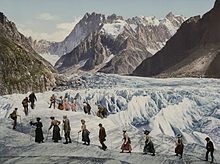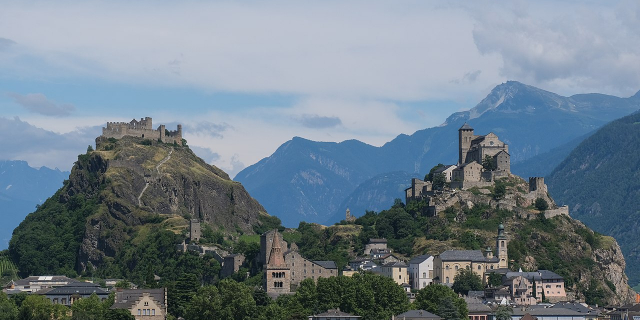Chamonix-Mont-Blanc (French pronunciation: [ʃamɔni mɔ̃ blɑ̃]; Arpitan: Chamôni-Mont-Blanc), more commonly known simply as Chamonix (Chamôni), is a commune in the Haute-Savoie department in the Auvergne-Rhône-Alpes region in Southeastern France. It was the site of the first Winter Olympics, held in 1924.
Chamonix is situated in the French Alps just north of Mont Blanc, the highest mountain in Western Europe. Between the peaks of the Aiguilles Rouges and the notable Aiguille du Midi, it borders both Switzerland and Italy. It is one of the oldest ski resorts in France, popular with alpinists and mountain enthusiasts. Via the cable car lift to the Aiguille du Midi it is possible to access the off-piste (backcountry) ski run of the Vallée Blanche (White Valley).
 Horace Bénédict de Saussure, with Jacques Balmat (left) who points towards the summit of Mont Blanc, Monument at Chamonix.
Horace Bénédict de Saussure, with Jacques Balmat (left) who points towards the summit of Mont Blanc, Monument at Chamonix.The valley was first mentioned in 1091, when it was granted by the Count of the Genevois to the great Benedictine house of St. Michel de la Cluse, near Turin, which by the early 13th century had established a priory there.[1] However, in 1786 the inhabitants bought their freedom from the canons of Sallanches, to whom the priory had been transferred in 1519.[citation needed]
In 1530, the inhabitants obtained from the Count of the Genevois the privilege of holding two fairs a year, while the valley was often visited by the civil officials and by the bishops of Geneva (first recorded visit in 1411, while St. Francis de Sales came there in 1606).[citation needed] But travellers for pleasure were very rare.
Chamonix was part of the historical land of Savoy emerged as the feudal territory of the House of Savoy during the 11th to 14th centuries. The historical territory is shared between the modern countries of France, Italy and Switzerland. The House of Savoy became the longest surviving royal house in Europe. It ruled the County of Savoy to 1416 and then the Duchy of Savoy from 1416 to 1860.[citation needed]
The first party to publish (1744) an account of their visit was that of Richard Pococke, William Windham and others, such as the Englishmen who visited the Mer de Glace in 1741. In 1742 came P. Martel and several other Genevese, in 1760 Horace Bénédict de Saussure,[1] as well as rather later Marc-Théodore Bourrit.
The growth of tourism in the early 19th century led to the formation of the Compagnie des Guides de Chamonix in 1821, to regulate access to the mountain slopes (which were communally or co-operatively owned), and this association held a monopoly of guiding from the town until it was broken by French government action in 1892; thereafter guides were required to hold a diploma issued by a commission dominated by civil servants and members of the French Alpine Club rather than local residents.[citation needed]
From the late 19th century on, tourist development was dominated by national and international initiatives rather than local entrepreneurs, though the local community was increasingly dependent upon and active in the tourist industry.[citation needed]
The commune successfully lobbied to change its name from Chamonix to Chamonix-Mont-Blanc in 1916.[citation needed] However, following the loss of its monopoly, the Compagnie reformed as an association of local guides, and retained an important role in local society; it provided the services of a friendly society to its members, and in the 20th century many of them were noted mountaineers and popularisers of mountain tourism, notably the novelist Roger Frison-Roche, the first member of the Compagnie not to be born in Chamonix.
 Chamonix Valley: crossing the glacier on foot (between 1902 and 1904)
Chamonix Valley: crossing the glacier on foot (between 1902 and 1904)Serving as the host city for the first Winter Olympic Games in 1924 further raised Chamonix's profile as an international tourist destination.
During the Second World War, a Children's Home operated in Chamonix, in which several dozens of Jewish children were hidden from the Nazis. Some of those who hid them were recognised as "Righteous Among the Nations".[2]
By the 1960s, agriculture had been reduced to a marginal activity, while the number of tourist beds available rose to around 60,000 by the end of the 20th century, with about 5 million visitors a year.[citation needed]


































Add new comment